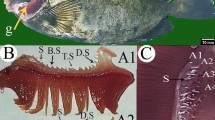Summary
It was noticed that the blind Mexican Cave Fish repeatedly passes along objects new to it at a short distance. Observations and experiments are reported which support the hypothesis that water movements occurring between the stationary object and the fish as it passes by convey information about the location and possibly the shape of the object, which is detected by the lateral line organ of the fish. Water movements of the expected type were recorded with the help of a model fish equipped with a mechano-electric analogue of a free neuromast.
Similar content being viewed by others
References
Campenhausen C von (1981) Die Sinne des Menschen, Bd I: Einführung in die Psychophysik der Wahrnehmung, Bd II: Anleitungen zu Beobachtungen und Experimenten. Thieme, Stuttgart
Dijkgraaf S (1967) Biological significance of the lateral line organs. In: Cahn PH (ed) Lateral line detectors. Indiana Univ Press, Bloomington, pp 83–95
Görner P (1963) Untersuchungen zur Morphologie und Elektro-physiologie des Seitenlinienorgans vom Krallenfrosch (Xenopus laevis Daudin). Z Vergl Physiol 47:316–338
Görner P (1967) Independence of afferent activity from efferent activity in the lateral line organ ofXenopus laevis Daudin. In: Cahn P (ed) Lateral line detectors. Indiana Univ Press, Bloomington, pp 199–214
Greguss P (1975) Holographic concept in nature. In: Greguss P (ed) Holography in medicine. Proc Int Symp Holography Biomed Sci. IPC Science and Technology Press, Guildford, pp 97–100
Hahn G (1960) Ferntastsinn und Strömungssinn beim augenlosen HöhlenfischAnoptichthy jordani im Vergleich zu anderen Te-leostiern. Naturwissenschaften 47:611
Heiligenberg W (1977) Principles of electrolocation and jamming avoidance in electric fish. A neuroethological approach. Studies of brain function, vol 1. Springer, Berlin Heidelberg New York
Hoch W (1981) Der lichtscheue Höhlenfisch. (personal communication)
Hubbs CL, Innes WT (1936) The first known blind fish of the family Characidae: a new genus from Mexico. Occas Pap Mus Zool Univ Mich 342:1–7
Kähling J (1961) Untersuchungen über den Lichtsinn und dessen Lokalisation bei dem HöhlenfischAnoptichthys jordani Hubbs et Innes (Characidae). Biol Zentralbl 80:439–451
Kalmijn J (1974) The detection of electric fields from inanimate and animate sources other than the electric organs. In: Fessard A (ed) Electroreceptors and other specialized receptors in lower vertebrates. Springer, Berlin Heidelberg New York (Handbook of sensory physiology, vol III/3. pp 147–200)
Kuhn O, Kähling J (1954) Augenrückbildung und Lichtsinn beiAnoptichthys jordani Hubbs et Innes. Experientia 10:385–388
Parzefall J (1974) Rückbildung aggressiver Verhaltensweisen bei einer Höhlenform vonPoecilia sphenops (Pisces, Poeciliidae). Z Tierpsychol 35:66–84
Russell IJ (1971) The role of the lateral-line efferent system inXenopus laevis. J Exp Biol 54:621–641
Schwartz E (1974) Lateral line mechano-receptors in fishes and amphibians. In: Fessard A (ed) Electroreceptors and other specialized receptors in lower vertebrates. Springer, Berlin Heidelberg New York (Handbook of sensory physiology, vol III/3, pp 257–278)
Thines G, Kähling J (1957) Untersuchungen über die Farbempfindlichkeit des HöhlenfischesAnoptichthys jordani Hubbes und Innes (Characidae). Z Biol 109:150–160
Voneida TJ, Sligar CM (1976) A comparative neuroanatomic study of retinal projections in two fishes:Astyanax hubbsi (the Blind Cave Fish), andAstyanax mexicanus. J Comp Neurol 165:89–106
Weber EH (1905) Tastsinn und Gemeingefühl. In: Ostwald's Klassiker der exakten Wissenschaften, Bd 149. Engelmann, Leipzig
Weissert R (1979) Dressurexperimente und Verhaltensbeobachtungn zum Formunterscheidungsvermögen des blinden HöhlenfischesAnoptichthys jordani (Hubbs et Innes). Dissertation, Mainz
Author information
Authors and Affiliations
Additional information
This research was supported by DFG Grant Ca 34/4
The technical devices were developed together with the master precision-instrument makers Mr. F. Hofmann and Mr. K. Wahnsiedler. The English of the paper was corrected and improved by Neil Beckhaus.
Rights and permissions
About this article
Cite this article
von Campenhausen, C., Riess, I. & Weissert, R. Detection of stationary objects by the blind Cave FishAnoptichthys jordani (Characidae). J. Comp. Physiol. 143, 369–374 (1981). https://doi.org/10.1007/BF00611175
Accepted:
Issue Date:
DOI: https://doi.org/10.1007/BF00611175




